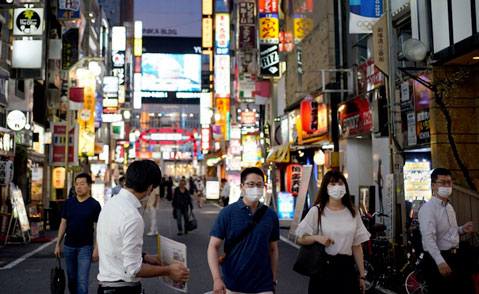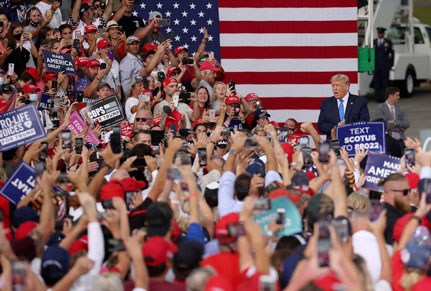Japan’s coronavirus success happened without the extensive lockdowns we saw in other countries. Japan avoided the Coronavirus pandemic’s worst effects – keeping its outbreak relatively small through expert understanding of the virus, coherent government and industry leadership, and the socially acculturated common sense of its populous.
It started with the docking of the Diamond Princess – a cruise ship that would become synonymous with the coronavirus outbreak’s early days. When she called on Japan in February 2020, waving a humanitarian SOS flag, the country was face to face with a problem – one of the many the Diamond Princes would trigger in other countries as well. The cruise ship was a veritable petri dish that threatened to marinate the Japanese archipelago. But in retrospect, Japan’s coronavirus approach and its results have left it atop the best performing countries in the battle against the virus.
While Japan is experiencing a recent surge in its second-wave infections, so far, only 2,487 people have died – fewer than the weekly run-rate in America in recent weeks. With just 18 deaths per million people, this is by far the lowest in the G7 countries of industrialized nations (Germany comes in a distant second, at 239). Yet Japan conducts the least testing of all G7 countries. It performs an average of 270 a day for every million people, compared with 4,000 or so in America and Britain.
So how did Japan manage this without the strict lockdowns, without the mass testing that is standard arsenal in the global battle?
“From the beginning, we did not aim at containment,” says Oshitani Hitoshi, a virologist who sits on an expert panel advising the government. He argues that this would require identifying all possible cases, which is not feasible in a country of Japan’s size when most infections produce mild or no symptoms. “Even if you test everyone once per week, you’ll still miss some,” he said.
Keys to Successful Approach
“Cluster Busting”

Japan’s high-quality universal health – accessible to all – is at the heart of its success. It increased and enhanced its testing capacity by introducing new technologies, such as saliva-based tests and ultrafast antigen testing. It focused heavily on contact tracing and “Cluster Busting.” The government and industry actively promoted telecommuting to keep people inside. Government subsidized 100% of the unemployed’s salary. And Japan’s disciplined and early adherence to mask-wearing (anathema to westerners) has made all the difference. The Japanese routinely wear masks to stave off hay fever and colds.
In a Wall Street Journal July 2, 2020 article, Japan’s Minister of State For Economic Revitalization and Minister in Charge of Covid-19 response, Yasutoshi Nishimura, explained Japan’s approach. He noted that Cluster-Busting works best when outbreaks are relatively small. Even though Japan had detected the first wave early, some clusters inevitably formed, prompting the government to declare a state of emergency on April 7. Voluntary business closures and other restrictions succeeded in reducing in-person contact by up to 80%, and the country lifted these after less than two months.
The core insight that has helped us in our fight against Covid-19 is the notion of transmission clusters. Early on, our health experts noticed that the disease spreads in a peculiar way. Although the coronavirus is highly contagious, it is not uniformly contagious. Most who are infected by it—about 80%—never pass it on to anyone else. The bulk of infections can be traced to a small number of “super-spreading events.” Just as striking, a person with mild symptoms, or even none at all, could easily cause a super-spreading event, or a cluster.
Because Covid-19 is a disease that spreads along relatively small numbers of super-spreading transmission chains, if you can isolate these chains or prevent them from forming, transmission of the virus isn’t sustainable.
Japan’s Minister of State For Economic Revitalization and Minister in Charge of Covid-19 response, Yasutoshi Nishimura
Successful Deployment of The Three Cs
According to Minister Nishimura, Japan developed a guide for avoiding high-risk situations that focused on the “Three Cs” that pose a significant risk of infection – closed spaces, crowded places, and close-contact settings, especially those involving loud talking. Extensive public-awareness campaigns with voluntary app-based monitoring then drilled awareness of avoiding those places and settings down even to Japanese children – all measures that suppressed a viral propagation.
Upfront, Japan accepted the economic costs that would accompany the reduction in person-to-person contacts as a reality. Contrast this with the United States, where multi-trillion dollar “bailouts” and the worst national tragedy (in terms of deaths) since the Civil War is the cost of failed leadership and individualism run amok.
After new cases declined, Japan’s cluster-based approach – particularly avoiding the Three Cs – remained central to suppressing virus transmission while allowing social and economic activities to resume. With expert advice, more than 100 industrial sectors, including the supermarket, restaurant, and entertainment industries, quickly established guidelines for conducting business while avoiding the Three Cs. Local health centers then performed the essential duties of contact tracing.
With news that one infected person at drug company Biogen’s February 2020 conference led to the infection of over 300,000 people globally adds new meaning to the significance of Japan’s approach.
Technology at Forefront of Success
Japan also actively promoted its “Digital New Deal” – an aggressive campaign promoting telework technology, which made working from home easier and kept people off Tokyo’s usually sardined-packed commuter trains.
Japan’s artificial-intelligence researchers also went to work with medical experts to develop ways to mitigate Covid-19 transmission using “Fugaku” – Japan’s newly developed supercomputer, ranked as the world’s most powerful. They developed simulations of droplet spread and contagion in restaurants that have influenced international guidelines put out by the World Health Organization (WHO).
Comparison to the West
In general, as we look across Asia, we cannot discount differences in acculturated social behaviors that have produced dramatically different Covid-19 results for us in the West. Inherent cultural obedience (a bad word that implies submissiveness in the West) has mostly paid off in many parts of Asia. In early April, American authorities were still advising against mask-wearing (from fear of running out of the short supplies available for health-care workers). But at that time, Europe was adapting to mask-wearing, while in Japan and elsewhere in Asia, it was the widespread and standard practice since January-February.

Take a mental snapshot of students’ Potemkin Villages on Florida’s crowded beaches in March or of the overcrowded malls and shopping centers we still see in the United States and Britain 8 months later.
We are hard-pressed to identify an effective contact-tracing app that is widely used in the United States, where Google, Facebook, and the tax authorities know everything about us, or in Europe, where there is available information though at a lesser degree. Most notably, the dystopian “freedom” claimed by Americans, Britons, Germans, and others as vehicles of viral propagation is not innate in Asia.

But additionally, were it not for an election year with an irresponsible and near-sociopathic president seeking re-election, we might not have had the super-spreading mass events (that Japan tackled early on with its Three Cs“).
Likewise, as the coronavirus had already established its deadly path in Italy and was on its way to Spain, the U.S. ceded prudence to the cause of a Democratic Primary Election campaign underway. It allowed commemoration of historical events with mass gatherings like the March 1 march across Alabama’s Edmund Pettus Bridge.
Were it not for across-the-board irresponsible state and local leaders’ refusal to mandate mask-wearing or to restrict mass congregation, America and Britain might have seen a fraction of the infection and death rate. Add the impact of a population wreaked by conspiracy theories, rank ignorance of biology, rejection of science in general, so many other rabbit holes of ignorance, individualism, short-sighted selfishness, and doom, no one can be surprised at our current state.

In America, though, the petri dish elements were uniquely ready to stew, and the results so far are those of a battle-hardened viral chef at work. Our capitalist system, rife with inequalities, renders any comparison to countries like Japan moot. Had America subsidized the unemployed and defined robust protocols for essential workers across industries, we would be in a different situation.
Stressful living and subpar food quality (nutrient-deficient) brought on by industrialized agriculture that depletes the soil of carbon and modifies and pumps sugars into the supply have left us in overall poor health with some of the highest rates of metabolic diseases in the developed world. To boot, our poor health-care system – lacking universal access and quality care, has made us ripe for a viral pandemic like Covid-19 to wreak havoc.
Yet these are issues that will never enter into public discussion as we wander into Santa’s wilderness this Christmas, awaiting a vaccine. Effectively, we have not yet evolved (way of life) to tackle a well-evolved viral pathogen. In addition to all of the above, in America and Europe, our great offense to humanity in the coronavirus era might be the lack of common sense and real leadership in the United States, Great Britain, Europe, and elsewhere in the West.
Spain, for example, having learned nothing from allowing a Women’s March in March 2020 that exploded the coronavirus in every city and town across the country, manifested its abject ignorance again this week. Madrilenian authorities found themselves on the defensive when videos of over 5,000 people in a Madrid stadium at singer Raphael’s concert surfaced online.
In a time when Covid-19 is cutting serious tracks across Spain, when the country is under a state of emergency with curfews, bar and restaurant closures, limits on congregations, and multiple levels of travel restrictions all over the country, the authorities in Madrid claim that the concert was “Covid-proof.” Supposedly, they allowed it to proceed because it “scrupulously followed social distance guidelines and the crowd size was only 30% capacity of the stadium’s capacity.“
As the virus takes no pause, time is critical, and wasted time has led to disaster. In the United States, as President Donald Trump politicized, delegitimized, and weaponized Covid-19, British Prime Minister Boris Johnson toyed with the pseudo-science of herd immunity and wasted precious early days minimizing the viral pandemic – until he was infected, almost died in an intensive care unit, and “found religion.”
As President Donald Trump withdrew the United States from the World Health Organization (WHO) amid a global pandemic, Mr. Johnson focused his efforts, not on battling the coronavirus, but on withdrawing his country from the family of nations in the European Union. Today, from a lack of common sense and abjectly failed leadership, both Anglo-Saxon giants are at the mercy of Covid-19 and its possible mutations.
The U.S, Britain, Europe, and to an extent, the rest of the world might have reaped some of the benefits of Japan and other Asian countries that were early in successfully tackling Covid-19. It is not too late for us to learn from Japan and others like South Korea, Taiwan, and New Zealand. As Minister Nishimura said,
“Humanity isn’t out of the woods yet. Defeating Covid-19 will take time, resources and global goodwill. All countries must move forward together, in a spirit of openness and cooperation.”
Japan’s Minister of State For Economic Revitalization and Minister in Charge of Covid-19 response, Yasutoshi Nishimura
I would add one thing to the minister’s ending assessment – the common sense of individuals.
If you like this story, please subscribe and share, if possible
